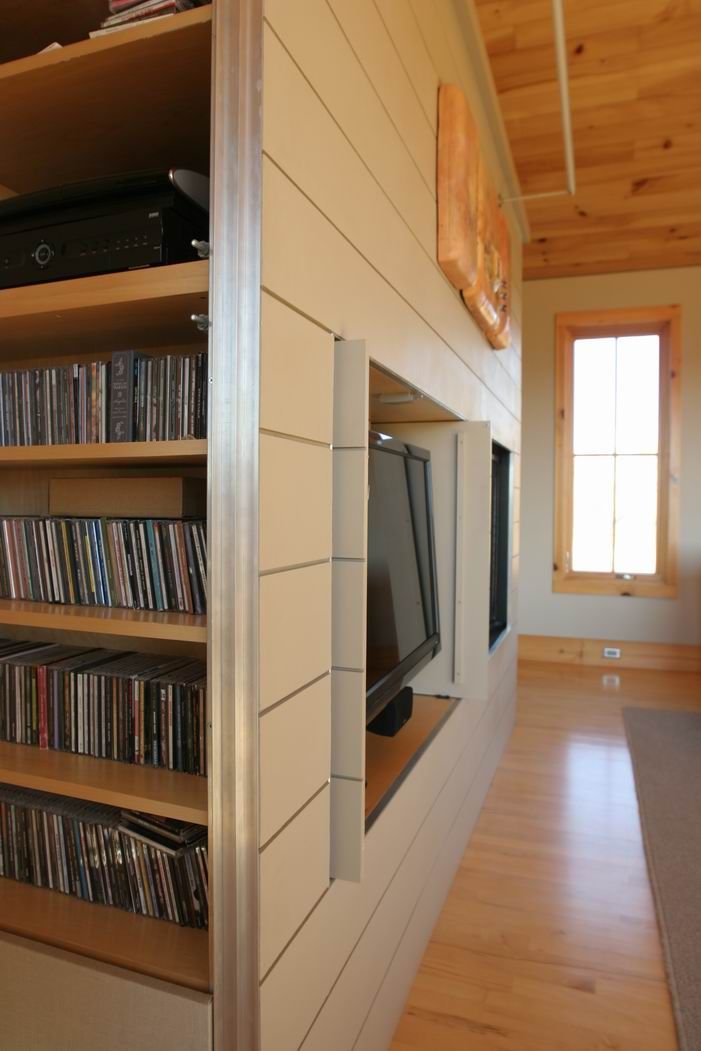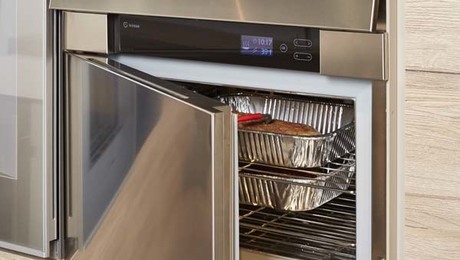
A lot of homeowners choose to put their TVs and stereo equipment on prominent display in the living room. Nowadays, it’s not uncommon to see the family flat screen bolted to the wall above the fireplace mantel. Not everyone is into that look, though, and the viewing experience can be awkward. (Read this article on how to sensibly position your TV).
Duncan McPherson, of Samsel Architects in Asheville, N.C., recently encountered a retirement couple who wanted to use their living room mostly for reading and relaxing. Since the living room shares a common space with the home’s dining room and kitchen, the clients wanted to keep the TV hidden most of the time. Duncan designed a custom built-in cabinet that highlights a gas fireplace, but keeps the clutter of TV and stereo equipment cleanly concealed. The unit is wrapped in fiber cement siding, which meets ASTM E 136 as a noncombustible material. Combined with a zero clearance fireplace, the arrangement offers the simplicity and safety the clients were looking for.
It’s not often that you see a modern home designed to keep technology at bay, but this design is certainly refreshing.
Architect: Duncan McPherson
*Interested in more information on this project? Look for a complete feature on this home in the coming months.
Fine Homebuilding Recommended Products
Fine Homebuilding receives a commission for items purchased through links on this site, including Amazon Associates and other affiliate advertising programs.

All New Bathroom Ideas that Work

A Field Guide to American Houses

All New Kitchen Ideas that Work


































View Comments
Nice! We've recently become tired of our entertainment center explosion in our living room: cords, devices, videos, video game controllers shoved haphazardly on our creaky entertainment center. We haven't even watched that much tv lately and would love to 'hide' all of this away without purchasing a large, bulky armoir. :)
Rob, while I am for the most part in agreement with this article, I think there are a few techniques which should be included in your article.
The first thing I notice when I look at the example above is the lack of symmetry. A fireplace out of center warrants a whole list of theoretical and philosophical concerns. But to most it just looks funny. A good method of handling this is to flank both sides of the fireplace with matching cabinets. One side could conceal the television while the other side could hold the a/v equipment or if using a natural fireplace it could just hold wood.
I think, if they would've planned ahead on this fire/entertainment centre they could've built the whole thing into the wall instead of jutting out into the room. Anytime you break the wall plane with a "built-in" the item degrades from being part of the house to being an object on the wall. With most built-ins, the more integrated, the better.
Looking at picture #3 above, I see the client has a collection of media. It should really be obvious by now that physical media, while still a viable method of purchasing content, is a horrible way of storing content. The price of large capacity hard drives (terra-towers) these days is lower than ever and the space savings - not to mention convenience of storing and accessing media in the digital environment is no longer the way of the future but everyday practice.
As a small note - if one should consider storing their a/v equipment in such manner as shown above it may be necessary to install a "remote eye" lest you will have to get up to adjust sound or pause the movie as most remote controls still cannot work through closed doors nor around corners.
Also note that the future of home a/v will be completely digital and almost entirely wireless (wifi). While when designing a built-in entertainment center it is still smart to plan ahead to provide wire chases and plenty of electrical outlets (mind your circuit loads!), the future of most a/v equipment points to wire free connectivity... which includes connecting to your laptop or tablet. In that sense it may be better to pre-plan your next built-in as a home command center rather than simply an entertainment center.
Finally, don't forget the heat. While a/v equipment has come a long way in terms of energy efficiency, it all still produces quantities of heat which must be mitigated if stored and used in a closed cabinet. Simple breather holes can be cut in the upper and lower rear of the cabinet (vented to the room) or you could even install heat sensing fans. Not venting your equipment could seriously shorten the life of the components.
Can't wait to read the article.
DC